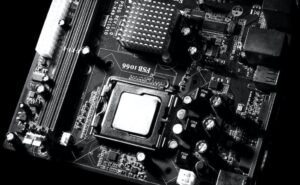SpaceX Benefits
SpaceX, founded by entrepreneur Elon Musk in 2002, is a private aerospace manufacturer and space transportation company. The company’s ultimate goal is to revolutionize space technology and create a self-sustaining colony on Mars. Over the years, SpaceX has brought numerous benefits to the field of space exploration and beyond.
Key Takeaways
- SpaceX has significantly reduced the cost of space travel.
- The company continues to push the boundaries of technological innovation.
- SpaceX’s reusable rockets have revolutionized the industry.
- Collaborations with NASA have further advanced space exploration.
Benefits of SpaceX
One of the major advantages of SpaceX is its ability to reduce the cost of space travel, making it more accessible and economically viable. By developing innovative technologies and reusable rockets, SpaceX has dramatically lowered the cost of delivering payloads to space. This has opened up possibilities for a range of applications, from satellite deployment to scientific research and even potential space tourism. *SpaceX has made space travel financially feasible for a wider range of organizations and individuals.*
Technological Advancements
SpaceX’s commitment to technological innovation has propelled the company to the forefront of the space industry. By continuously pushing the boundaries of engineering and design, SpaceX has pioneered advancements in rocket engines, fuel efficiency, and vehicle reusability. The development and successful landing of the Falcon 9 rocket represents a major breakthrough, proving the concept of reusable rockets and significantly reducing the cost of launching payloads into space. *SpaceX’s relentless pursuit of innovation sets them apart from other aerospace companies.*
Collaborations with NASA
In addition to its own ambitious projects, SpaceX has also collaborated extensively with NASA. These partnerships have resulted in notable achievements, such as the development of the Dragon spacecraft and the Commercial Crew Program. Through these collaborations, SpaceX has helped to enhance capabilities for space exploration, space station resupply missions, and potentially even crewed missions to Mars in the future. *The cooperation between SpaceX and NASA has accelerated the progress of space exploration as a whole.*
SpaceX Launches by Year
| Year | Number of Launches |
|---|---|
| 2010 | 2 |
| 2015 | 7 |
| 2020 | 26 |
Benefits of Reusable Rockets
| Benefit | Description |
|---|---|
| Cost Reduction | Significantly lowers the cost of space missions by reusing rockets instead of building new ones for every launch. |
| Sustainability | Reduces the amount of space debris and contributes to a more sustainable approach to space exploration. |
| Efficiency | Enables quicker turnaround times between launches, increasing overall launch capacity and mission frequency. |
SpaceX Achievements
| Achievement | Date |
|---|---|
| First privately-funded liquid-fueled rocket to reach orbit (Falcon 1) | September 2008 |
| First privately-funded spacecraft to be recovered from orbit (Dragon) | December 2010 |
| First privately-funded spacecraft to dock with the International Space Station (Dragon) | May 2012 |
Further Benefits and Impact
The benefits of SpaceX extend beyond the realm of space exploration. The company’s technological advancements and cost reduction strategies have stimulated innovation and competition within the aerospace industry. This has led to more affordable satellite launches and increased access to space for research and commercial purposes. Furthermore, the pursuit of Mars colonization has sparked public interest and reinvigorated enthusiasm for space exploration. *SpaceX’s achievements have paved the way for a new era of space innovation and exploration.*
In conclusion, SpaceX represents a game-changing force in the aerospace industry. Through cost reduction, technological innovation, and collaborations with NASA, SpaceX has initiated a new phase of space exploration and commercial space endeavors. The company’s achievements and advancements continue to inspire and shape the future of human space exploration and lay the groundwork for a potential interplanetary society.

Common Misconceptions
Misconception 1: SpaceX is a waste of taxpayer money
One common misconception surrounding SpaceX is that it is a waste of taxpayer money. However, this is not entirely true as there are several benefits that taxpayers can gain from the investment.
- SpaceX generates jobs and stimulates the economy through its operations.
- The advancements made by SpaceX in space technology can have numerous civilian applications, including satellite communication and transportation.
- SpaceX’s efforts in reducing the cost of space launches can potentially lead to more affordable access to space for various organizations and research institutions.
Misconception 2: SpaceX is only focused on space tourism
Another misconception is that SpaceX is solely focused on space tourism and has no real contributions to science and technology. However, this assumption is far from the truth.
- SpaceX’s main objective is to reduce the cost of space travel, making it more accessible for scientific research and exploration.
- The company has developed and launched several advanced satellites that contribute to important global services, such as weather monitoring and global positioning systems.
- SpaceX has also collaborated with NASA on various projects, including the resupply missions to the International Space Station.
Misconception 3: SpaceX is competing against NASA
There is a common misconception that SpaceX is in direct competition with NASA and aims to replace the government agency, which is not entirely accurate.
- SpaceX collaborates with NASA on multiple missions, and both entities have a shared goal of expanding human presence in space.
- The partnership with SpaceX has allowed NASA to reduce its dependence on Russian spacecraft for crewed missions to the International Space Station.
- SpaceX’s success has sparked innovation and renewed interest in space exploration, benefiting the entire industry.
Misconception 4: SpaceX is neglecting safety in its space missions
Some people argue that SpaceX prioritizes speed and efficiency over safety in its space missions, which is a misconception.
- SpaceX has implemented stringent safety measures and follows strict protocols to ensure the well-being of its crew members and the success of its missions.
- The company has made significant advancements in rocket recovery and reusability, which inherently enhances safety by reducing the risks associated with discarding expensive rocket components.
- SpaceX continually learns from previous missions and iterates on its designs to improve safety and reliability.
Misconception 5: SpaceX is solely focused on Mars colonization
While SpaceX has extensive plans for Mars colonization, there is a misconception that it is exclusively devoted to this goal. However, SpaceX has a broader vision for space exploration.
- SpaceX aims to establish a sustainable presence on Mars, but it also has objectives to explore the Moon and potentially other destinations in the solar system.
- The company’s Starship spacecraft is designed for long-duration space travel, with capabilities that extend beyond just Mars missions.
- SpaceX’s ambitions for Mars colonization drive innovation and push the boundaries of space exploration, benefitting scientific understanding and technological advancements.

SpaceX Rockets: A Game-Changer in the Space Industry
SpaceX, founded by Elon Musk in 2002, has revolutionized the space industry in numerous ways. From lowering the cost of space travel to enabling new missions and sending humans to Mars, SpaceX has become a driving force in advancing space exploration. The following tables showcase some of the remarkable achievements and benefits of SpaceX:
1. First Private Company to Dock with the International Space Station (ISS)
SpaceX made history on May 25, 2012, when its Dragon spacecraft became the first privately-funded vehicle to successfully reach and dock with the ISS, marking a significant milestone in space exploration.
| Mission | Date | Result |
|---|---|---|
| COTS Demo Flight 2 | May 22, 2012 | Successful launch and orbit insertion |
| COTS Demo Flight 2 | May 25, 2012 | Successful docking with the ISS |
2. Reusable Falcon 9 Rockets
SpaceX’s Falcon 9 rockets are designed to be reusable, significantly reducing the cost of space exploration. By landing the first stage booster back on Earth after delivering its payload to space, SpaceX has eliminated the need for building entirely new rockets for every launch.
| Rocket Name | Number of Successful Landings |
|---|---|
| Falcon 9 | 49 |
3. Starship: Next-Generation Mars Colonization
SpaceX’s Starship is a fully reusable spacecraft designed to carry humans and cargo to destinations like the Moon, Mars, and beyond. It represents a significant step towards Elon Musk‘s vision of establishing a self-sustaining city on Mars.
| Starship Prototype | Date | Note |
|---|---|---|
| Starship SN8 | December 9, 2020 | First high-altitude flight and landing attempt |
| Starship SN15 | May 5, 2021 | First high-altitude flight and successful landing |
4. Dragon Version 2: Human Spaceflight Capability
SpaceX’s Dragon Version 2 spacecraft is designed to transport astronauts to and from the ISS. With its crewed missions, SpaceX has restored the United States’ domestic capability to launch humans into space following the retirement of the Space Shuttle program.
| Mission | Date | Result |
|---|---|---|
| SpaceX Demo-2 | May 30, 2020 | First crewed flight of Dragon V2, carried NASA astronauts to the ISS |
| Crew-1 | November 15, 2020 | First operational crewed mission, carried astronauts to the ISS |
5. Deployment of Starlink Constellation
SpaceX’s Starlink project aims to create a global satellite internet network, providing internet access to even the most remote areas of the planet. The following table shows the current status of Starlink’s satellite constellation:
| Launch | Date | Number of Satellites |
|---|---|---|
| Starlink v1.0 L9 | October 18, 2021 | 1,800+ |
| Starlink v1.0 L18 | In Progress | TBD |
6. Falcon Heavy: Most Powerful Operational Rocket
The Falcon Heavy is currently the most powerful operational rocket in the world, capable of launching heavy payloads into space. Its successful debut flight marked a significant leap in SpaceX’s launch capabilities:
| Launch | Date | Note |
|---|---|---|
| Falcon Heavy Demo Flight | February 6, 2018 | Successful launch, payload included Elon Musk’s Tesla Roadster |
7. Commercial Resupply Services for NASA
SpaceX’s partnership with NASA’s Commercial Resupply Services (CRS) program has enabled regular cargo resupply missions to the ISS, ensuring the continuous provision of essential supplies and research materials for the crew:
| Mission | Date | Result |
|---|---|---|
| CRS-1 | October 7, 2012 | First operational cargo resupply mission to the ISS |
| CRS-22 | June 3, 2021 | Recent successful cargo resupply mission |
8. Crewed Lunar Missions
SpaceX is actively working on facilitating crewed lunar missions and has been awarded NASA contracts for this purpose. These missions will pave the way for future human exploration and establish a sustainable presence on the Moon:
| Mission | Date | Note |
|---|---|---|
| Artemis II | 2023 (Planned) | First crewed lunar flyby mission since Apollo 17 |
| Artemis III | 2024 (Planned) | First woman and next man on the Moon |
9. Crew-2 Mission Collaboration
SpaceX’s collaboration with international partners demonstrates the company’s commitment to fostering international cooperation in space exploration. The Crew-2 mission showcased this partnership by sending astronauts from NASA, ESA, and JAXA to the ISS:
| Mission | Date | Astronauts |
|---|---|---|
| Crew-2 | April 23, 2021 | 2 NASA, 1 ESA, 1 JAXA |
10. Impact on Space Tourism
SpaceX’s technological advancements have also paved the way for space tourism, allowing private individuals to experience space travel. The upcoming Inspiration4 mission will serve as an inspiring example of civilian space exploration:
| Mission | Date | Participants |
|---|---|---|
| Inspiration4 | September 2021 (Planned) | First all-civilian crew |
SpaceX’s groundbreaking achievements have revolutionized the space industry, pushing boundaries and making space more accessible than ever before. Through its innovative rockets, spacecraft, and missions, SpaceX continues to inspire generations and lay the foundation for future space exploration endeavors.
Frequently Asked Questions
What are the benefits of investing in SpaceX?
Investing in SpaceX offers a unique opportunity to participate in the commercial space industry, which has significant growth potential. As a vertically-integrated company, SpaceX is involved in various sectors such as satellite launches, space tourism, and Mars colonization, presenting potential long-term profits for investors.
How does SpaceX contribute to technological advancements?
SpaceX is at the forefront of space technology and has driven many technological advancements. From developing reusable rocket technology to creating advanced satellite systems, SpaceX pushes the boundaries of innovation. These advancements benefit not only space exploration but also have broader applications in Earth-based industries, such as improved telecommunication systems and remote sensing capabilities.
What role does SpaceX play in reducing space travel costs?
SpaceX revolutionized space travel by developing reusable rockets. By recovering and refurbishing rocket boosters, SpaceX significantly reduces launch costs. This innovation has made space travel more cost-effective and commercially viable, opening up opportunities for research, satellite deployment, and space tourism.
How does SpaceX contribute to environmental sustainability?
SpaceX’s commitment to reusable rockets helps reduce the environmental impact of space travel. By recycling materials and reducing the need for new rocket production, SpaceX minimizes waste and lowers carbon emissions associated with space launches. This emphasis on sustainability aligns with broader global efforts to protect the environment.
What are the benefits of SpaceX’s Starlink satellite constellation?
The Starlink satellite constellation aims to provide global broadband internet coverage. This technology can benefit underserved areas with limited access to reliable internet connections. It enables improved communication, access to educational resources, telemedicine services, and supports global connectivity efforts, fostering economic development and social inclusion.
How does SpaceX contribute to scientific research and exploration?
SpaceX collaborates with government agencies, research institutions, and private companies to support scientific research and exploration initiatives. By providing reliable launch services, SpaceX enables the deployment of satellites, telescopes, and scientific instruments, facilitating various research projects, including space telescopes, weather monitoring, Earth observation, and planetary exploration missions.
What impact does SpaceX have on job creation and the economy?
SpaceX’s activities have a positive impact on job creation and economic growth. Its operations require a skilled workforce across various disciplines, supporting direct employment opportunities. Additionally, SpaceX’s partnerships and contracts with other companies in the aerospace industry contribute to a larger ecosystem of jobs and economic development.
How does SpaceX contribute to national security?
SpaceX’s capability to launch satellites and cargo to space strengthens national security by providing a reliable and domestic launch capability. This reduces dependence on foreign launch providers, ensuring secure and timely access to space for government and military purposes.
What are the health benefits of SpaceX’s efforts in space tourism?
Space tourism endeavors by SpaceX offer significant health benefits related to research on human physiology in microgravity. By conducting studies on astronauts and space tourists, SpaceX contributes to advancing our understanding of human biology, potentially leading to breakthroughs in medical research, disease treatments, and advancements in healthcare.
How does SpaceX contribute to inspiring future generations?
SpaceX’s achievements inspire future generations to explore science, technology, engineering, and mathematics (STEM) fields. Through live broadcasts of rocket launches, educational initiatives, and their ambitious space exploration plans, SpaceX encourages young minds to pursue careers in space exploration, engineering, and innovation.




